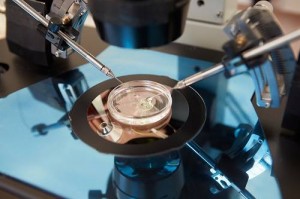FDA Mulling Three-Parent Embryo Creation
 While some European ethicists and politicians have called for an end to the creation of “three-parent” IVF embryos, the U.S. Food and Drug Administration has announced it is considering allowing the practice – without having held a public consultation.
While some European ethicists and politicians have called for an end to the creation of “three-parent” IVF embryos, the U.S. Food and Drug Administration has announced it is considering allowing the practice – without having held a public consultation.
Researchers say that the technique “modifies standard IVF technology” to create an embryo from the eggs of two women and sperm from one man.
The FDA’s most recent draft guidance on the issue included no mention of the ethical concerns over the nature of the procedure itself, but only offers suggestions for developing early stage clinical trials.
“This guidance is intended to facilitate [cellular and gene therapy] development by providing recommendations regarding selected aspects of the design of early-phase clinical trials of these products,” the document said.
The FDA’s Cellular, Tissue and Gene Therapies Advisory Committee had planned on holding a public consultation in Silver Spring, Maryland, on October 22-23, but an announcement said they had postponed it because of the federal government shutdown.
No new consultation date has been announced.
Among those objecting to the FDA’s proposal is the Arkansas-based Family Council, who have published their response to the consultation, listing three reasons the creation of children with three genetic parents should not be allowed.
First, they said, the technique, like human embryonic stem cell research, inevitably involves the creation of human embryos whose sole purpose is to be “created and killed in the name of science.”
They also said that the research, while it is purported to be about preventing genetic disorders, “could also be used by polygamous or polyamorous ‘families’ to ‘create’ children biologically-related to all the adults involved in the relationship.”
The document also warns of potentially wide-ranging issues in law and public policy related to child welfare or parental rights, all of which currently “assumes children have two biological parents.”
“While it’s fairly common for children to be reared by only one parent, or for someone other than a biological parent to have custody of a child, it is not known what damage could be done to the rights of two-parent children if the laws change to accommodate parents of three-parent children,” the group said.
The Vatican is on record against the procedure. The document, Dignitas Personae, by the Congregation for the Doctrine of the Faith, says that, since all research used to develop such therapies starts with the artificial creation of human embryos, most of which are then destroyed, “it must be stated that, in its current state, germ-line cell therapy in all its forms is morally illicit.”
Much of the objection to the proposal comes from the fact that alterations to mitochondrial DNA (mtDNA) result in genetic changes that will be carried down the line of inheritance when the embryo becomes an adult and has his or her own children.
This “germ-line” genetic therapy was condemned by the 2008 CDF document, which said when “genetic modifications are effected on the germ cells of a person will be transmitted to any potential offspring,” the procedure cannot be morally licit.
The ethics of the procedure are not the only concerns. The Scientist also reports that some clinical “safety” issues remain unresolved. The researchers who developed the technique reported genetic abnormalities in about half the embryos created, and other researchers have expressed concerns “about the compatibility of the mitochondrial and nuclear DNA from two different donors.”
Most of the research community is dismissive of such concerns. In 2012, Sir Mark Walport, then head of the UK’s Wellcome Trust, described mitochondrial gene transfer as merely the equivalent of “changing the batteries in a camera.” The trust had just awarded a grant of £5.8 million to researchers at Newcastle University, a major center for embryo research.
The procedure was described in an article in The Scientist as a means of avoiding the various pathologies caused by genetic anomalies in the mitochondria, the tiny organelles found in the cytoplasm that act as “batteries” providing power to an organism’s cells.
In it, the nucleus from the ovum of a woman carrying “mitochondrial defects” is transferred into the second “donor egg,” whose cytoplasm is free of the mitochondrial defects and from which the nucleus has been removed.
The result is an ovum, (oocyte or female gamete) that has the nuclear DNA of the first woman, but with the defect-free cytoplasm of the second woman. The resulting genetically modified ovum is then fertilized with the sperm, becoming an embryo which can be implanted in the “donor” who has the mitochondrial disorder.
The technique was developed by a team of biologists at Oregon Health and Science University in Beaverton in 2009, which created healthy rhesus monkeys free of mitochondrial genetic disorders. In 2012, the same team announced success in human trials, having created a dozen human embryos, all of which were later “destroyed,” who had no mitochondrial disorders.
Those with concerns may contact the FDA:
Gail Dapolito
Phone: 301-827-1289,
Fax: 301-827-0294
e-mail: (Enable Javascript to see the email address)
Writers are asked to use “Cellular, Tissue and Gene Therapies Advisory Committee Meeting Comment” as the e-mail’s subject line.

